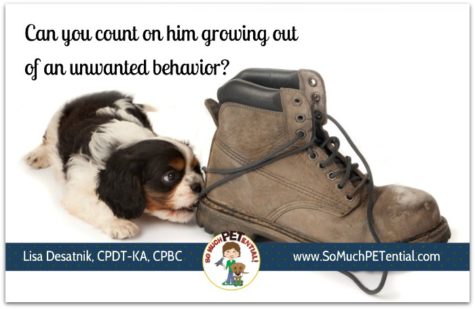Puppies chew. They play. They run. They get into things we do not want them to. They vocalize. They grab things on impulse. They also may show signs of backing away from unfamiliar things in their environment of signs of pulling toward other things.
Oh so cute they are! We love them for their adorableness but get so frustrated with their bad habits. But, won’t they grow out of those habits?
While it is true that biologically there are certain behaviors puppies are prone to do like destructive chewing for both teething relief and an outlet for young energy, what is important to realize is that every waking moment puppies – just like all animals – are learning from experience. They are learning constantly associations between behaviors and consequences. Quite simply, those behaviors that are serving to get something of value (from the perspective of the learner) are going to be ones that are repeated. AND if those behaviors get the animal something it values only sporadically, then you will see an even stronger, longer lasting, virulent behavior.
What does this mean for you as a puppy owner (or any pet owner)?
Well, take for example that unwanted chewing of shoes. While a puppy’s natural clock gives it a great need for chewing and destroying, the more times he gets positive reinforcement for that behavior, the more he is likely to repeat it. And often humans add to the value of that destructive chewing and destroying by giving the puppy attention or a game of chase when it has something in its mouth.
While puppies do go through developmental fear periods, if a puppy startles, moves back from or growls at something in its environment; or exhibits elevated heart rate, barking or digging when its human leaves the room, it is a mistake to think that behavior will just magically go away as the dog matures. In fact, those behaviors may more than likely strengthen and even generalize to other fear responses later. If, for example, a man in a white coat gives a puppy a painful injection then later other people in white coats may also cause elevated heart rates, etc. Remember that learning also teaches negative associations between behaviors and consequences/neutral and conditioned stimulus. This is why it is so important to teach young puppies early on that their world is a good place by exposing them carefully and positively to a wide range of environments, people, objects, sounds, and other stimulus (doing this by providing positive outcomes for your puppy and ensuring by watching its body language that it is feeling good in that moment).
Management is a critically important step in puppy training to help young minds grow in ways you want them to. By working to prevent those unwanted behaviors from being practiced (and building a reinforcement history for them) while also focusing on giving your puppy opportunities to practice wanted behaviors with positive consequences, you will be helping your pet and you to have many happy years together.
As a puppy owner, you have an important role in helping your puppy get its needs met in appropriate ways while building value for behaviors and habits you want to see more of…for the rest of your relationship together.









